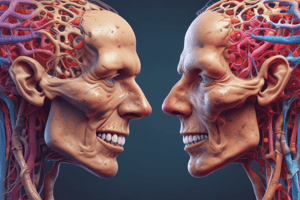Podcast
Questions and Answers
What proportion of children will develop Huntington disease if one of their parents is affected?
What proportion of children will develop Huntington disease if one of their parents is affected?
- 25%
- 100%
- 50% (correct)
- 75%
What is the function of the CAG triplet repeat in people with Huntington disease?
What is the function of the CAG triplet repeat in people with Huntington disease?
- Terminates protein synthesis
- Codes for the amino acid asparagine
- Codes for the amino acid glutamine (correct)
- Initiates DNA replication
What is thought to contribute to cell death in Huntington disease?
What is thought to contribute to cell death in Huntington disease?
- Excessive signaling of neurons (correct)
- Mitochondrial dysfunction
- Mutated protein aggregation in astrocytes
- Inadequate signaling of neurons
What is a consequence of the expanded CAG repeats on DNA replication?
What is a consequence of the expanded CAG repeats on DNA replication?
What is the effect of repeat expansion during development?
What is the effect of repeat expansion during development?
What is the primary reason for the phenomenon of anticipation in Huntington disease families?
What is the primary reason for the phenomenon of anticipation in Huntington disease families?
What is the term for the process of adding more CAG repeats to the protein, leading to the development of a mutation?
What is the term for the process of adding more CAG repeats to the protein, leading to the development of a mutation?
Why are people with 36-39 repeats said to show reduced penetrance?
Why are people with 36-39 repeats said to show reduced penetrance?
What is the significance of 40+ CAG repeats in a person?
What is the significance of 40+ CAG repeats in a person?
Why is the test for HD, which counts the number of CAG repeats, very good at determining whether HD will develop in an at-risk individual?
Why is the test for HD, which counts the number of CAG repeats, very good at determining whether HD will develop in an at-risk individual?
Flashcards are hidden until you start studying
Study Notes
Huntington Disease (HD)
- A rare neurodegenerative disease caused by a repeated sequence of DNA that leads to an abnormal protein formation, resulting in abnormal movements and cognitive problems.
- An autosomal dominant genetic disorder, meaning one affected copy of a gene is enough to cause disease.
Genetic Characteristics
- Typically, the gene called huntingtin or HTT on chromosome 4 contains a triplet repeat of C, A, and G nucleotides 10-35 times in a row.
- In people with HD, this repeat goes on for 36 or more times in a row.
- The CAG repeat codes for the amino acid glutamine, resulting in 36 or more glutamines in a row in the huntingtin protein.
Effects of HD
- The mutated protein aggregates within the neuronal cells of the caudate and putamen of the basal ganglia, causing neuronal cell death.
- Cell death might be related to excitotoxicity, which is excessive signaling of these neurons, leading to high intracellular calcium.
DNA Replication and Repeat Expansion
- The expanded CAG repeats affect DNA replication, causing DNA polymerase to lose track of which CAG it's on, resulting in extra CAGs being added.
- This expansion occurs during cell divisions, leading to ample opportunities for repeat expansion, making the gene more unstable.
Anticipation and Inheritance
- The phenomenon of anticipation means that HD families often show earlier symptom onset with each generation.
- Children of a parent with HD can inherit even more CAG repeats than the parent, leading to an earlier age of symptom onset.
- Repeat expansion occurs more in the production of sperm than eggs, resulting in anticipation and new disease alleles when the father is the affected parent.
Penetrance and Diagnosis
- A person with 40+ repeats shows 100% penetrance and will have the disease.
- People with 36-39 repeats can show reduced penetrance, with some having symptoms while others may not.
- The test for HD, which counts the number of CAG repeats, is effective in determining whether HD will develop in an at-risk individual.
Studying That Suits You
Use AI to generate personalized quizzes and flashcards to suit your learning preferences.



